|
FAQs about Marine Crab (Including some
Anomurans) Identification 16
Related Articles: Crabs, Hermit
Crabs,
Related FAQs: SW
Crab Identification 1, SW Crab ID
2, SW Crab ID 3, SW Crab ID 4, SW
Crab ID 6, Marine Crab ID 7,
Marine Crab ID 8, Marine Crab ID 9, Marine
Crab ID 10, Marine
Crab ID 11, Marine
Crab ID 12, SW Crab ID 13,
SW Crab ID 14, SW Crab ID 15, SW
Crab ID 17, SW Crab ID 18,
SW Crab ID 19,
SW Crab ID 20,
SW Crab ID 21,
SW Crab ID
22,
& Marine Invertebrate
identification, Marine Crabs
1, Marine Crabs
2, Marine Crabs 3, Marine Crabs 4, & Crab Behavior, Marine Crab
Selection, Marine Crab
Compatibility, Marine Crab
Systems, Marine Crab
Feeding, Marine Crab
Reproduction, Marine Crab
Disease, Micro-Crustaceans,
Amphipods, Copepods, Mysids, Hermit
Crabs, Shrimps,
Cleaner
Shrimps, Banded Coral
Shrimp, Mantis
Shrimp, Anemone
Eating Shrimp, Crustacean Identification, Crustacean Selection, Crustacean Behavior, Crustacean Compatibility, Crustacean Systems, Crustacean Feeding, Crustacean Disease, Crustacean Reproduction,
|
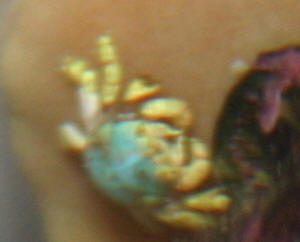 |
|
Unidentified Crab -- 2/23/10
Hello again!
<Hello Frank, Lynn here today.>
I was wondering if you all could help me tell what kind of crab I
got here. My buddy at the LFS gave him to me after I spotted him
in their live rock tank where it must have hitched a ride. It
looks VERY similar to an emerald crab.
<Does it have the same flattened/scooped claw tips (as opposed
to pointed)?>
It has the hairy legs but it is a reddish brown color. I've
been looking at some pics of different species (strawberry crab,
ruby crab, and others) but I'm just not sure if I should add
him to my tank with my corals and mandarin.
<Personally, I wouldn't, but it's up to you. Crabs are
opportunistic omnivores and scavengers that pose an increasing
risk to livestock as they increase in size. A hungry crab will
eat whatever it can grab. Keeping the crab well fed with sinking
pellets or meaty bits of marine origin can help deter unwanted
predation, but there are no guarantees.>
I'm attaching pics so I hope they come through. Let me know
what you think.
<Unfortunately, I can't see enough detail in the photos to
be of much help. The general carapace shape and striped legs do
appear to resemble Mithraculus/Mithrax forceps (aka the
Red-Ridged Clinging Crab), but I could be way off. Please see the
following links for comparison/more information:
http://www.dnr.sc.gov/marine/sertc/images/photo%20gallery/Mithraculus_forceps_S806.jpg
http://www.wetwebmedia.com/Arthropoda/CrustaceanPIX/SWCrabs/Crab%20IDs/SWCrabs2.htm
One thing I'd like to point out is that even if this is a
Mithraculus/Mithrax crab, it still presents a potential risk to
livestock. What has me more concerned is the possibility that
this crab could be something else entirely. It could be a species
that grows in size and aggression fairly quickly. That could be a
big problem, and believe me, trapping an entrenched crab can be
quite a challenge. It's a shame really. Crabs are such neat
little creatures. Unfortunately, they just can't be trusted
long-term around other livestock.>
..and thanks again for all your hard work.
<You're most welcome. Good luck with the crab!>
Frank
<Take care, LynnZ>
|
 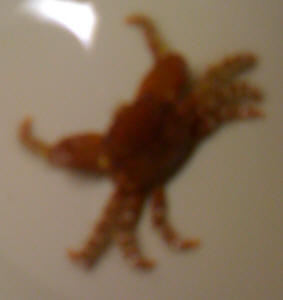 |
Crab Identification: Porcellanid -- 2/23/10
Hello WWM crew,
<Hello Adam, Lynn here today.>
I have a question about a crab I recently found in my reef tank.
<Fire away>
I noticed someone else asking about what I think may be a similar crab
on 1/24/10. That post noted Porcellanid but I have searched and not
found anything that resembles this crab.
<Unfortunately, you may not be able to. There are many species, not
all of which are available as photos on the web or within readily
available books. Beyond that, there are species that haven't yet
been formally described. For example, your little fellow could be
locally known as 'Bob's crab' in some corner of the
tropics, but until it's studied, described, and presented to the
rest of the world, the chances of us running across any
information/photos range somewhere between slim and none. It's
frustrating, I know, but for our purposes, it's often enough to
know which family the crab in question belongs within.>
Unfortunately I do not have a picture as it is the smallest crab I
personally have ever seen. Perhaps 1/2 cm across.
<It could be a juvenile or simply one of the smaller species.
Typically, these crabs are fairly small, with carapaces no larger than
1/2" across.>
It is a tan color but instead of claws it has 2 filter fans.
<Yep, you've got a Porcelain crab, aka a "false" crab
("Anomuran") in the family Porcellanidae. These crabs have 3
pairs of walking legs (as opposed to 4 in
"true"/"Brachyuran" crabs), two claws (usually
large, used mostly for territorial disputes but can be quickly shed
when crab feels threatened), one significantly smaller pair of legs
used for grooming that are held up against the abdomen or posterior end
of carapace, two long antennae just behind the eyes, and two specially
adapted fan-shaped mouthparts used to filter organic particles/plankton
out of the water. As for the missing claws in your individual, they
could have been dropped due to a perceived threat/stress, or lost due
to injury/predation.>
They look just like feather dusters but are clear. It sits in the same
spot all the time and I only see it at night with the flashlight. It
just sits there and filters away with these fans. Opening and closing
them in the current.
<Terrific observations! This behavior is typical of Porcellanids.
Thankfully, they're filter feeders and scavengers that don't
normally pose too much risk in a mixed reef system. I would offer it
the occasional sinking pellet or meaty bit (of marine origin) such as
shrimp, clam, silverside, or Mysis to supplement its diet. Unless you
have a fully mature reef system, the crab may not be able to acquire
sufficient food from the water column alone. For more information,
please use our Google search engine and the terms Porcellanid or
Porcelain crab: http://www.wetwebmedia.com/Googlesearch.htm >
Any insight would be greatly appreciated!
<Hopefully the above information/Google search results will help. If
not, please don't hesitate to contact me/us. In the meantime, enjoy
your little Porcelain crab!>
Adam Thompson
<Take care, LynnZ>
|
Another 'Crab ID': Must Be Porcelain Crab
Season! 3/2/10
Hello WWM Crew!!!!
<Hello Sandra, Lynn here with you today!>
This little guy fell out of a piece of live rock I was moving out
of my fish only tank.
<Wheee!>
I'm going to put him in my refugium as I know there are no
truly reef safe crabs except for the commensal crabs in SPS
corals.
<They're one of the safer groups anyway. They're
generally small and stay within/around their particular coral,
feeding on coral mucus, a bit of tissue and whatever else they
can find.>
I have several of those and wouldn't dream of removing
one.
<Good, I'd leave and enjoy them.>
He appears to be a filter feeder maybe in the Porcelain Crab
family,
<You hit the nail on the head. It's a classic Porcellanid
(family Porcellanidae) showing the distinctive 3 pairs of walking
legs, two large claws and long antennae just behind the eyes. If
you look closely, towards the back of the carapace on either side
you'll see another small pair of legs folded up and held
against the body. These are used for grooming. Up front, you can
see the large mouth parts that open up into the distinctive
fan-like structures used to filter organic particulate matter and
plankton from the water column. All in all, it's a neat
little crab.>
..but, of course, I couldn't find a picture that looks
exactly like this guy.
<That's understandable. There are many, many, crab species
out there. Knowing where the crab originated would help, but even
then, it can be a considerable challenge. Sometimes you get lucky
with a very common, well-known species, but most of the time
narrowing the ID to family level is about as good as it
gets.>
I have 2 in my 300 gallon SPS tank that don't appear to be
bothering anything in their vicinity so I wanted to ask while I
happened to have this one out what kind he is
<Unfortunately, a Porcellanid is about as far as I can take
this ID without having the little crab in front of me to see all
the pertinent/distinguishing details.>
..and could get a decent picture of him. If I need to get out the
trap then I will.
<Well, if you want to keep that particular tank a fish-only,
I'd move the crab to the 300g display. Porcellanids are
generally small and don't have much negative impact on a reef
system. They do scavenge as well as filter feed though, so
I'd recommend offering it the occasional pellet food or meaty
bits (of marine origin). Sometimes these crabs aren't able to
obtain enough food from filter-feeding alone.>
The pictures don't show the color as well as I would have
liked but he does have some red and blue accents.
<Yes, they show up fairly well after enlarging the photos.
It's actually a very pretty little crab.>
I didn't know I even had this one until I took the rock out
of the water and he fell out. The ones in my 300 I've only
seen at night and they are actively moving their antennae and
look like they are filter feeding.
<Typical behavior>
I haven't seen them picking anything off the rocks. I have 6
separate refugiums I could put him in. 3 with a DSB, rubble and
Chaeto. 2 with larger and smaller pieces of rubble and Chaeto.
And 1 with just rubble and Chaeto. Which refugium should I put
him in to give him the best environment? I want him to have the
right home.
<Hmmm, I'd either put him in the 300g display as mentioned
above, or put him in one of the fuges with a DSB. You might want
to add a couple of larger rubble pieces though so he'll have
a place to hide. Crabs and other crustaceans like to hole-up in a
secure spot when they molt as they're particularly vulnerable
until their shell hardens. One other issue with the fuge relates
to the Chaeto. Just make sure there's enough room at the
bottom for the crab to crawl around. I've seen Chaeto take
off to the point where it's packed top to bottom. For more
information on Porcelain crabs, please see WWM, starting with the
FAQ's at this link:
http://www.wetwebmedia.com/SWCrabIDF15.htm >
Thank you all so much for the volumes of information and advice
over the years.
<On behalf of Bob and the crew, you're very
welcome.>
The changes you have made to the site to make information easier
to find in the last year is awesome. Maybe 1 day you could add an
image search feature similar to google image search so you could
scan through "hitchhiker crabs" images and click on the
picture to go directly to the referenced page. That would be
really, REALLY awesome.
<That's a great idea!>
Thank you,
<You're very welcome.>
Sandra
<Take care, LynnZ>
|
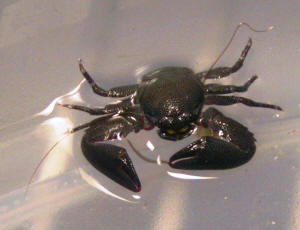 |
|
Crab Identification? Xanthid -- 2/5/10
Play slideshow<
http://g.msn.com/5meen_us/171?path=/photomail/{fde9e2f7-aa51-431a-9cf2-108f5d4b6049}&image=10755EA654B0231F!679&imagehi=10755EA654B0231F!677&CID=1185958145360405279>
Save all photos Want to save all these photos at once? Learn how
<http://help.live.com/help.aspx?mkt=en-us&project=WL_Mailv3&querytype=keyword&query=segami_lla_evas>
Online pictures are available for 30 days
<Hello Randy, Lynn here today.>
I have a large guest that snuck in on some live rock.
<Surprise!>
I have been chasing this guy for a month and finally caught
him.
<Ah, success at last!>
Not sure what kind of crab it is or if it is reef safe.
<It depends on what you mean by reef safe, but all in all, you
did the right thing in removing it.>
I noticed shells lying around the rocks he was staying under, but
I don't know if the shells were occupied before he got
them.
<Unless the empty shells were there before the crab moved in,
or you've got a Mantis shrimp somewhere in the vicinity,
I'd say he probably ate them. Crabs like this tend to prey on
bivalves, snails, sessile invertebrates, worms, other
crustaceans, etc., as well as scavenge. All in all, they're
opportunists that will eat whatever they can get their claws
on.>
The rock came from a 220 gal reef tank with 400 Lb of rock. I
happened to get him in rock from that tank. Can anyone ID him for
sure?
<I can tell you that it's something in the family
Xanthidae. That's about the best I can do without having the
crab right in front of me. Even then, I'd be doing well to
narrow it to genus level. There are just so very many genera and
species within this large family that trying to take it further
with a single photo is pretty much impossible - for me,
anyway!>
Fish stores around here keep telling me different things, from a
fiddler
<Negatory>
..to a strawberry crab.
<I guess it depends on what they call a strawberry crab, but
what you have is not one of those usually associated with this
name.>
He is 3 in wide, 1.5 in front to back, when he spreads his claws,
about 6 in tip to tip.
<Holy guacamole, he must have been hiding in the equivalent of
the cavernous 'bat cave' within those rocks!>
Hope to put him in my refugium.
<You could, but it would no longer be a refuge for the other
beneficial critters within. I'd consider putting it in a tank
of its own, or finding it another home altogether. These crabs
are neat little creatures but can be very destructive. Further
compounding the issue is that as their size grows so does their
appetite.>
http://public.bay.livefilestore.com/y1pwqRZfPvtqN0xqLqysyC10g2jUlgRqPgJ8ZI_cPCn6R8u8IHzRc
S81M92U_ADaJ6RJnA9i6DibQ-T53uWvlSNDA/crab.JPG?download
Thanks
<You're very welcome.>
Randy
<Take care, LynnZ>
|
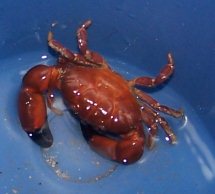 |
|
Unidentified Marine Crab - 2/2/10
Hello WWM,
<Hello Mark, Lynn here this evening.>
I found an unidentified crab in my reef tank and wonder if you
know what crab it is
<I'm sorry, but I can't see enough pertinent details
to be sure.>
..and whether or not I should leave it in the tank?
<It's probably fine right now because it's so small,
but as with any other crab, risk increases with size,
opportunity, and competition/lack of sufficient food.>
I've observed it briefly; it seems to pick the rocks for
algae. I've attached a photo for your convenience. Any
information you can provide or point me to would be greatly
appreciated.
<Well, crabs are neat little creatures, but I don't trust
any of them. Even those that seem to be primarily herbivorous can
and will eat just about anything if they get hungry enough and
the opportunity comes along. Basically, you've got a couple
of choices. Either trap/remove the crab now and find it a new
home in the sump or elsewhere, or let it hang out for awhile and
keep a sharp eye on things. If you do choose to let it remain, be
sure to keep it well fed with meaty bits (of marine origin), or
sinking pellets. Please see WWM for more information, starting
here: http://www.wetwebmedia.com/swcrabcomp.htm
>
Thank you.
<You're very welcome.>
Regards,
Mark
<Take care, LynnZ>
|
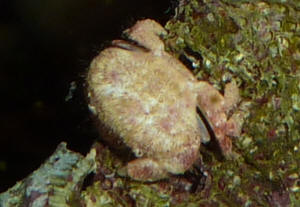 |
|
ID Crab: Porcellanid -- 1/27/10
Hi Crew,
<Hello there, Lynn here this evening.>
Is this a porcelain crab?
<It certainly is. It appears to be Petrolisthes galathinus, or
at least one of the species within this complex. Common names
include the Purple Porcelain crab and Banded Porcelain crab
(family: Porcellanidae). They're primarily filter feeders,
but will scavenge as well. Bob has also noted that they're
not to be trusted around other invertebrates so beware if you
have any. See this link re:
http://www.wetwebmedia.com/galatheids.htm
>
I don't keep crabs not even hermits because I have a small
tank with small fish.
<That's understandable. Fortunately, these shy, mostly
nocturnal crabs stay fairly small (carapace width to ~1/2").
Those big claws are mainly for territorial squabbles and are
sometimes shed if/when the animal feels threatened. See this link
for a photo of P. galathinus feeding.
http://www.animal-image.com/CoralReef/Crabs/Banded%20Porcelain%20Crab/slides/BandedPorcelainCrab_PetrolisthesGalathinusTRCr_Ap8R.php
>
Got this by mistake in an order. Keep it or not?
<It's up to you. While these crabs pose less threat than
say, a big Xanthid, they're still scavengers. I just
can't tell you for certain that it won't go after
sleeping fishes if it gets hungry enough or the opportunity
presents itself. One way to lessen those chances further is to
keep the crab well fed with meaty bits (of marine origin),
sinking pellets, etc. Honestly, I think it's a neat little
crab. As long as I didn't have a tank full of tiny fishes
(gobies and the like) I'd be tempted to give it a chance.
Take care and good luck, LynnZ>
|
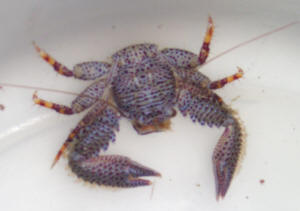 |
Crab Identification, no pic! 1/24/10
Sorry to bother you for some help on a crab identification. I have been
looking online for hours (trying to help someone with an ID). I came
across this crab once and can't remember for the life of me what is
was. I do not
have a picture, but here is the description.
About 1.5" and white. It does not have any claws, but in their
place, filter feeding fans (not to be confused with the anemones on the
boxer or pom pom).
Thanks for your help.
Bret Yaworski
<Mmm, freshwater? Maybe summat of the genus Attya (shrimp) or in
this family... Marine? Poss. a Porcellanid family member... whose claws
are often obscured, mouthparts are of filter feeders. Bob
Fenner>
|
Crab ID 1/4/2010
Hello Crew.
<Erik>
I am in the process of trying to catch some of the crabs in my
Red Sea reef tank. Most all need to go. I have already caught one
shamefaced crab.
There is at least one more of these. I have attached a picture of
one crab that may be ok to keep. I believe it to be a Black
Mithrax. Note in the picture the round plates at the end of the
pinchers. He feeds heavily on algae, but obviously will consume
meat as a small piece of shrimp was used as the bait. Should he
stay or go?
<Mmm, please see Lynn's input on our forum, here:
http://74.125.155.132/search?q=cache:ZjLAMxocUDcJ:bb.wetwebmedia.com/viewtop
ic.php%3Ff%3D25%26t%3D189+black+mithrax&cd=1&hl=en&ct=clnk&gl=us
Also, many of the other crabs are very small and I have not had
luck
catching them in the traps. Only the larger crabs get caught. Is
this normal?
<Not atypical, no>
I am using a small canning jar tilted against the rock with a
small piece of shrimp in the bottom. Is there a better trap for
smaller crabs?
<Whatever works... the small, all-plastic rodent traps (or
repackaged/labeled ones for aquarium use) from Home Depot,
Lowe's et all... are my faves... have a dropping un-openable
(by them) trap door... aka "Have-A-Heart" traps for
terrestrial use>
Thanks again for all the great information. I am certain I would
not be having the success I am having without this site.
Kind Regards,
Erik Hayes
<Welcome! Bob Fenner>
|
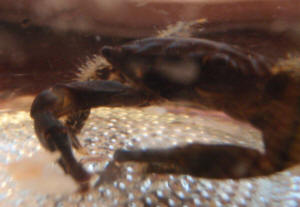 |
|
Crab ID 12/7/09
Hello all,
<Misael>
I found and plucked this little crab off of a coral that I
believe to be Turbinaria reniformis. I've searched around for
an id, but can't find anything and I need to decide soon
whether to put it back or not.
<Interesting... can you send larger, more-resolved images?
This looks to be a Pinnotherid to me... that usually live w/in
the mantle spaces of bivalves>
I'd love to keep it, but don't want to put it back in if
it's harmful. I've had this coral for about 7 months and
never noticed any obvious damage to it or any other tank
inhabitants.
Thanks!
- Misael
<Do you have any clams? As you've had this animal for so
long, and it appears small, I would put it back, keep it. Bob
Fenner>
|
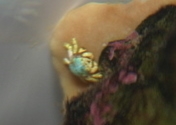 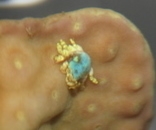 Full size pix Full size pix
|
Re: Crab ID --
12/08/09
Hi Bob,
<Misael>
Thanks for your quick response. I put it back in tank and
it eventually crawled into a little hole in the middle of
the coral that I never paid attention to before.
Unfortunately, I didn't get any more pictures of it
before putting it back and it's not really visible at
the moment. I attached the same two pictures but at maximum
resolution in case that's
helpful.
<It is... to an extent>
I tried Googling Pinnotherid and Pinnotheridae, but I
haven't yet found another one that looks quite like
this one.
Thanks again,
- Misael
<Mmm, well, my best guess to family is now the
Trapeziidae... "coral crab" family... But my
scant home references, mostly general marine invert. books,
some regional, and Debelius' Crustaceans of the World,
nor searches on Google with the family name, color
characteristics, w/ or w/o the genus (Turbinaria) or family
(Dendrophylliidae) show this animal... I suspect that it is
mildly bothersome to the coral, but like yourself, I'd
keep it as part of the livestock here. I am going to put
your query in LynnZ's in-folder (she's much more
adept at these ID's than I) and hope she or a browser
will chime in w/ more.
Cheers, Bob Fenner>
|
 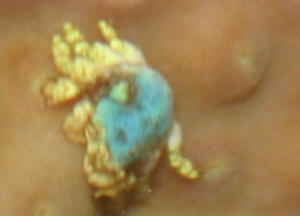 |
|
Re: Follow-up Re: Crab ID --
12/11/09
Bob and Lynn,
<Hello Misael, Lynn here this morning>
Thanks for all the great info on this little critter.
<On behalf of Bob any myself, it was a pleasure.>
From what I've seen so far, the gall crab seems to be
the closest so far to what I have. I noticed it this
morning in another hole nearby where it originally went
into, assuming I have only one.
<Yep, if it is indeed a gall crab, there could be
several females in the vicinity.>
Hopefully it'll give me more opportunities to take
better pictures.
<Sounds great! Send them along when/if possible!>
Thanks again!
<You're very welcome!>
- Misael
<Take care, LynnZ>
|
Follow-up Re: Crab ID --
12/9/09
Hi Bob,
<Hi Misael, Lynn here chiming in today.>
Thanks for your quick response. I put it back in tank and it
eventually crawled into a little hole in the middle of the coral
that I never paid attention to before.
<Can be hard to see!>
Unfortunately, I didn't get any more pictures of it before
putting it back and it's not really visible at the moment. I
attached the same two pictures but at maximum resolution in case
that's helpful.
<Thanks, every bit of information we can get is
helpful.>
I tried Googling Pinnotherid and Pinnotheridae, but I haven't
yet found another one that looks quite like this one.
<Like Bob, I've gone through a ton of sources but
haven't found anything that exactly matches your little
fellow either. Unfortunately, there are just so many crab species
out there that even with very detailed photos, you're often
lucky to narrow things to family level. One possibility, beyond
what Bob offered, is a coral gall crab (family Cryptochiridae).
Naturally, there are many genera within this family and many
species beyond that. Unfortunately, I can only find photos of a
few species within this entire family, but here are a few
examples:
http://decapoda.free.fr/illustration.php?n=1&sp=2056
See photos towards the bottom of the page at this link:
http://www.marinelifephotography.com/marine/arthropods/crabs/crabs.htm
The following is an excellent Adobe PDF file with ID keys for the
family Cryptochiridae. Pay particular attention to the shape of
the carapace in the various illustrations. Note the similar
elongate proportions front to back, the shape/anatomy of the
anterior/front leading edge (where eyes are), etc. :
http://scholarspace.manoa.hawaii.edu/bitstream/10125/1293/1/v44n4-417-448.pdf
The above link originated at this address:
http://scholarspace.manoa.hawaii.edu/handle/10125/1293
This link should help with the various anatomical terms, etc.,
listed within the above PDF file:
http://webs.lander.edu/rsfox/invertebrates/callinectes.html
Coral gall crabs live within half-moon to round shaped holes
('galls') formed within a coral as a result of the
crab's irritation of its tissues. These crabs tend to live in
pairs with the female eventually becoming trapped within the
gall, while the smaller male is able to go out and about to feed
and mate with other nearby females. Gall crabs are usually pretty
small and reportedly feed on the host coral's mucus and a bit
of tissue. Luckily, they don't seem to damage the coral
enough to do significant harm. Personally, I'd leave the
little fellow in there and enjoy watching him! Please see the
following link for various examples of coral galls:
http://www.naturalis.nl/asp/page.asp?alias=naturalis.nl&view=naturalis.nl&id=i000256&frameurl=http%3A%2F%2Fwww.naturalis.nl%2Fget%3Fsite%3Dnaturalis.nl%26view%3Dnaturalis.nl%26id%3Di001650%26logId%3Dl000009%26execute%3Dshowsingleitem
>
Thanks again,
<You're most welcome.>
- Misael
<Take care, LynnZ>
|
Re: LPS ID.. Now Decapod ID, sans pic! 11/6/09
Hi Crew,
Bob, Thank you for your advice, I did not buy that coral...
Now I have one more question. A 7 months ago, when I just started my
tank, I got live rocks. Then one month later I noticed one tiny crab,
less then 1/4 inch, looked like green emerald, with hairy legs and same
kind of feeding behavior, just completely black. This thing is growing
so fast, and now it is about 1.5 inch. Is still crapping algae and does
not bother other tank mates. I can not get a picture because it spend
all the time between rocks. Can you tell me what it is, how save to
keep it in my tank, and if it is not save, how to get rid of it?
<Nope>
Thank you very much for your help and everything you do to help people
like me.
Best regards,
Igor
<Need images Igor. Please read through here:
http://www.wetwebmedia.com/swcrabidfaqs.htm
and the linked files in the series above. BobF>
|
Mystery Crab: Likely Anomuran: Porcelain Crab --
10/17/09
Hi
<Hello Jan, Lynn here this morning.>
I have a new Red Sea Max 1250 tank set up just with live rock for
the moment and have 3 crabs? These have a large claw, small order
pincer thing and banded legs but the body is tiny, much smaller
than the big claw. They seem to feed by two feeler things which
go up and down to the mouth in sequence and these have two large
fans attached. Look a bit like a Spanish dancing girl!
<Heee! Very observant! What you describe is typical of
Porcelain crabs (family Porcellanidae). Those 'fans' are
used to filter organics/plankton from the water. For more
information on these neat little 'false' crabs, please
see the FAQ titled 'Mystery Crab (actually an Anomuran) --
Likely Porcelain Crab -- 8/16/09' at the following link:
http://www.wetwebmedia.com/squatlobfaqs.htm >
Any idea what they are and if dangerous,
<Luckily, they're not dangerous to humans (beyond the
possibility of getting pinched), but like most crabs, they're
opportunistic critters so do keep them well fed as noted at above
link.>
I have not yet put anything in the tank just cleaning crew snails
and a blued legged hermit.
<Oh, you're just getting started! Enjoy the process and
all the critters that show up, including these neat little
guys!>
Many thanks.
<You're very welcome, it was my pleasure.>
Jan Randall
<Take care, Lynn Zurik> Re: Mystery Crab: Likely
Anomuran: Porcelain Crab -- 10/17/09
Hi Lynn
<Hi Jan!>
Many thanks for the fast reply.
<All due to your terrific description!>
I think the animal is an Anomuran although mine don't look
like any picture so far, so is probably Anomuranrandallis!
<Heeee! There are many genera and species in the family
Porcellanidae so identification to species level can be a real
challenge. If you can get together some good photos though, and
tell me where the crabs/rock originated, I'd be glad to give
it a try. I may not get it to species level but I might be able
to narrow it to genus. Even that can be an accomplishment! If you
do get a chance to take some photos, try to get a good one from
above showing the carapace, all the legs, and the claw arms.
Also, if you can get a good close-up of both claws/arms, that
would be terrific. The more detail you can capture, the better
chance we have of success! Oh, and one last thing, if you remove
the crab to a bowl of tank water to take photos (keep crab
submerged), don't be too surprised if the little fellow loses
a claw or two. These guys sometimes drop them when feeling
threatened/stressed, but with good health/husbandry, they should
be back within a few molts.>
Great to know I can ask the experts when I get stuck.
<Heeee! I'm no expert, but I'm happy to help
anyway!>
Best wishes, Jan.
<Same to you, Jan. Take care, LynnZ>
Re: Mystery Crab: Likely Anomuran: Porcelain Crab --
10/18/09
<Hi Jan>
Right, will have a go when I can.
<Sounds great. I look forward to seeing the little
fellows!>
Best wishes, Jan.
<Thanks, Jan. Take care, LynnZ>
|
| Me too. |
Stuff, Decapod ID ESP, More likely development of a content
provider in our interest -- 10/22/09
Dear sir/madam,
<... will you read my book?>
I have two questions.
<I have considerably more. Let's start with yours though>
Firstly, I have a hitchhiker crab, I was wondering can you tell the
type by it's cast off carapace?
<Perhaps>
I've been trying to lure him out, kill him, and trap him in a jar
to no avail. I know that it has red eyes, a tanned body and two white
stripes between its eyes. Just want to know what type it is. I can send
a picture of the shell if needs be. The left over shell had small black
spots on the claws too if that helps.
<Uhhh>
Secondly, I was reading on the site about some of the WWM team being
writers for publications regarding aquatics and would like some advice.
I work in a aquarium shop in Belfast (Exotic Aquatics), and I've
got a degree
in newspaper journalism, and I'm interested in fish but I've
been trying to write pieces on fish., on equipment, etc, and I just
can't seem to transfer from news to fish. I mean, I know a good bit
about aquatics but there's a
lot I don't too and I'm looking to get a bit of income out of
writing so even just a few areas to stick my nose in an get a few
stories would be good. If this could be passed on to Mr. Fenner or
anyone else who publishes work, that would be kind of whoever has to
read this.
Kind regards,
Bob Malcolm
<Bob... do write your submissions into Neale Monks and Andrew Nixon
(our co-editors of our online 'zine... and both Britons...) and
let's see if we can help you on your way to becoming a pet-fish
content producer! Bob Fenner>
|
|

